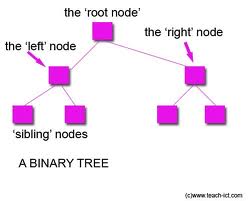 Success finally! I have been trying to create and work with binary trees in Lisp for sometime. It is really difficult in Lisp in which there are no real data structures. Trees are so obvious in a language like C where one can visualize the left & right branches with pointers. The structure of a node in C is
Success finally! I have been trying to create and work with binary trees in Lisp for sometime. It is really difficult in Lisp in which there are no real data structures. Trees are so obvious in a language like C where one can visualize the left & right branches with pointers. The structure of a node in C is
struct node tree{
int value
struct node *left;
struct node *right;
}
Lisp has no such structures. Lisp is a list or at best a list of lists. It is really how the program interprets the nested list of lists that makes the list a binary or a n-ary tree. As I mentioned before I have not had a whole lot of success in creating the binary tree in Lisp for quite sometime. Finally I happened to come across a small version of adding an element to a set in “Structure and Interpretation of Computer Programs (SICP)” by Harold Abelson, Gerald and Julie Sussman. This is probably one of the best books I have read in a long time and contains some truly profound insights into computer programming.
I adapted the Scheme code into my version of a adding a node. Finally I was able to code inorder, pre-order and post order traversals.
(Note: You can clone the code below from GitHub : Binary trees in Lisp)
In this version the a node of a binary tree is represented as
(node left right) so
node -> (car tree)
left_branch -> (cadr tree)
right_branch is -> (caddr tree)
Here is the code
(defun entry (tree)
(car tree))
(defun left-branch (tree)
(cadr tree))
(defun right-branch (tree)
(caddr tree))
//Create node in a binary tree
(defun make-tree (entry left right)
(list entry left righta))
// Insert element into tree
add (x tree)
(cond ((null tree) (make-tree x nil nil))
((= x (entry tree)) tree)
((< x (entry tree)) (make-tree (entry tree) (add x
(left-branch tree)) (right-branch tree)))
((> x (entry tree)) (make-tree (entry tree)
(left-branch tree) (add x (right-branch tree))))))
So I can now create a tree with a create-tree function
(defun create-tree(elmnts)
(dolist (x elmnts)
(setf tree (add x tree)))
)
(setf tree nil)
NIL
(setf lst (list 23 12 1 4 5 28 4 9 10 45 89))
(23 12 1 4 5 28 4 9 10 45 89)
(create-tree lst)
NIL
Now I display the tree
tree
(23 (12 (1 NIL (4 NIL (5 NIL (9 NIL (10 NIL NIL))))) NIL) (28 NIL (45 NIL (89 NIL NIL))))
This can be represented pictorially as

Now I created the 3 types of traversals
(defun inorder (tree)
(cond ((null tree))
(t (inorder (left-branch tree))
(print (entry tree))
(inorder (right-branch tree))))))
(defun preorder (tree)
(cond ((null tree))
(t (print (entry tree))
(preorder (left-branch tree))
(preorder (right-branch tree))))))
(defun postorder (tree)
(cond ((null tree))
(t (postorder (left-branch tree))
(postorder (right-branch tree))
(print (entry tree)))))
[89]> (inorder tree)
1
4
5
9
10
12
23
28
45
89
[90]> (preorder tree)
23
12
1
4
5
9
10
28
45
89
T
[91]> (postorder tree)
10
9
5
4
1
12
89
45
28
23
23
Note: A couple of readers responded to me saying that I very wrong in saying that Lisp has no data structures. I would tend to agree that Lisp would have evolved over the years to include data structures. I hope to pick on Lisp some time later from where I left off!. Till that time….
You may also like
1. A crime map of India in R: Crimes against women
2. What’s up Watson? Using IBM Watson’s QAAPI with Bluemix, NodeExpress – Part 1
3. Bend it like Bluemix, MongoDB with autoscaling – Part 2
4. Informed choices through Machine Learning : Analyzing Kohli, Tendulkar and Dravid
5. Thinking Web Scale (TWS-3): Map-Reduce – Bring compute to data
For all posts see Index of posts

Hi Tinniam V Ganesh,
Don’t mind negative opinions. Thanks to your work (even if it could be slightly improved) I could easily write my own version of Binary trees in my Lisp dialect, lambdatalk : http://epsilonwiki.free.fr/lambdaway/?view=BT
And I thank you 🙂
LikeLike
@Alain thanks for the comments. Nice code.
LikeLike
Unintentional Hilarity is Unintentional. And also hilarious.
Or would be, if there wasn’t a real risk of some unsuspectimg soul stumbling on it and reading it and being forever damaged by it…
LikeLike
@Careless Lisper. Thanks for your comments. I now realize that binary tree in lisp are fairly trivial. Anyway at that time it was a challenge.
LikeLike
it is one of the best solution on lisp based BST. i used to search and tried many codes for this assignment but no one worked or explained in so cleared manner as you are. Thank you so much
LikeLike
Thanks.
LikeLike